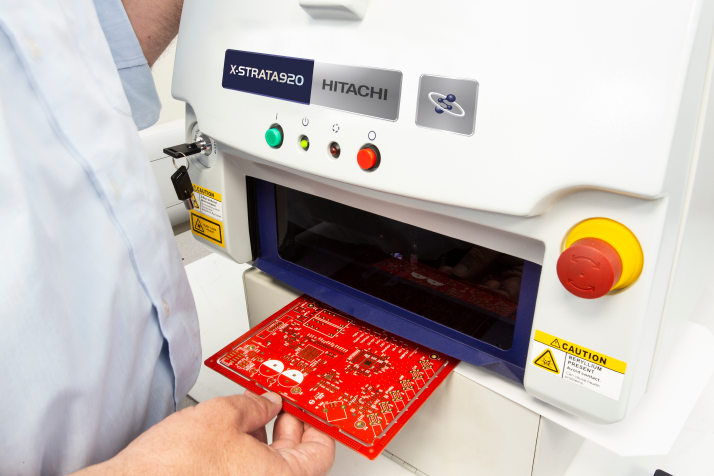August 2017 saw the release of the highly-speculated IPC-4552B requirements that specify the thickness of the immersion gold and electroless nickel plating on ENIG coatings for printed circuit boards (PCB). The new requirements are designed to create a standard of peak performance for ENIG coatings across the electronics industry by reducing hyper-corrosion, but they have also created new challenges for manufacturers and suppliers.
X-ray fluorescence (XRF) has long been the approved method of testing ENIG coating thickness, and every company working with the coating will likely be using one. The release of IPC-4552B means that many older instruments are simply incapable of measuring with the precision needed to make sure the gold layer meets the new specifications.
The specification focuses on whether the ENIG plating process can produce a normal distribution for nickel and gold deposit thickness, but also that the end products are all uniform. This means that XRF analyzers need to be accurate, reliable and reproducible.
One of the biggest challenges for manufacturers will be the demonstration of an acceptable level of corrosion, meaning that increased measurement and observation are likely to be required. This means ensuring that a low-cost solution for accurate and reliable coating thickness analysis is going to be a top priority for many companies going forward.
Some in the industry have worried that the need for increased XRF analysis time could create bottlenecks in production, making device reliability hugely important.
The good news for operators is that the Hitachi High-Tech X-Strata920 is capable of delivering measurement results that comply with IPC-4552B.

Everyone in the electronics supply chain, from chemical suppliers to OEMs, must do their part to ensure that products meet the standards set by the IPC. The XRF analyzers being used as part of process control must be able to perform a Type 1 Gauge R&R study using a reference standard that falls within the defined gold and nickel thickness ranges.
The X-Strata920 does not meet the new gauge capability but is still a compliant instrument due to further details of IPC-4552B. Provisions in the new specifications say that instruments that don’t meet the target limits can be used if it uses guard bands on the plating range. Guard bands define operating limits that account for statistical error and mean that X-Strata920 measurements comply with the thickness requirements.
There are a number of other technical questions that operators may have with regards to the viability of their current device. The new specifications do not dictate what kind of EDXRF detectors a company can use, or what kind of collimator. They also allow for mechanical collimation or capillary optic, but the spot size must be appropriate for the pad being measured. The X-Strata920 provides users with flexible collimator selection in order to provide analysis sensitivity as well as speed.
The X-Strata920 combines IPC-4552B compliance with market-leading accuracy, value for money and the need for minimal user training. Large sample areas can be analyzed in a single measurement cycle using the multi-point analysis function and the user can return to specific points for detailed investigation if needed.
With over 800 pre-loaded calibration packages tailored for a wide range of materials screening applications and easy-to-select application parameters and methods, the X-Strata920 is not just a compliance tool for IPC-4552B. It’s operational flexibility and accuracy means that it also meets other international test methods such as ASTM B568 and ISO 3497.
The simple user interface and advanced security and safety features mean that routine operators can make sure that the products you manufacture meet the new standard while also providing manager-level access for system set up. The analyzer can even perform operations unattended, helping to increase production process downtime and increase productivity across your operations. For manufacturers concerned that the need for increased XRF analysis time will negatively affect their production process, the ability to leave the X-Strata920 ticking over in the corner and be sure of the accuracy and quality of the results is a great feature.
Detector equipment is often a long-term purchase, meaning that while rugged design is important, making sure that the solution is future-proofed has been a high priority for Hitachi High-Tech. The X-Strata920 has been designed to adapt to your operations as they change over time.
You may only need the X-Strata920’s proportional counter if operations require the accurate and reliable measurement of single elements. If you need to analyse multiple elements at a single time or think the coatings you use could change in the future, the Silicon Drift Detector (SDD) provides a high level of additional performance. By using less noise, the SDD is better able to detect thinner coatings and give a clear view of the gold peak.
With over 40 years’ experience in providing the world’s leading industries with cutting-edge XRF solutions, we know how pivotal international standards are to providing end users with high quality products. But complying with international standards can have negative consequences if it loads to increased costs and inefficacies in production. The X-Strata920 is an optimum solution for manufacturers looking to comply with IPC-4552B while increasing productivity and guaranteeing accuracy of measurement. For more information get in touch with our experts.